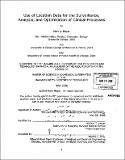Use of location data for the surveillance, analysis, and optimization of clinical processes
Author(s)
Meyer, Mark A. (Mark Aaron)
DownloadFull printable version (2.901Mb)
Other Contributors
Harvard University--MIT Division of Health Sciences and Technology.
Advisor
William T. Lester.
Terms of use
Metadata
Show full item recordAbstract
Location tracking systems in healthcare produce a wealth of data applicable across many aspects of care and management. However, since dedicated location tracking systems, such as the oft mentioned RFID tracking system, are still sparsely deployed, a number of other data sources may be utilized to serve as a proxy for physical location, such as barcodes and manual timestamp entry, and may be better suited to indicate progress through clinical workflows. INCOMING!, a web-based platform that monitors and tracks patient progress from the operating room to the post-anesthesia care unit (PACU), is one such system that utilizes manual timestamps routinely entered as standard process of care in the operating room in order to track a patient's progress through the post-operative period. This integrated real time system facilitates patient flow between the PACU and the surgical ward and eases PACU workload by reducing the effort of discharging patients. (cont.) We have also developed a larger-scale integrated system for perioperative processes that integrates perioperative data from anesthesia and surgical devices and operating room (OR) / hospital information systems, and projects the real-time integrated data as a single, unified, easy to visualize display. The need to optimize perioperative throughput creates a demand for integration of the datastreams and for timely data presentation. The system provides improved context-sensitive information display, improved real-time monitoring of physiological data, real-time access to readiness information, and improved workflow management. These systems provide improved data access and utilization, providing context-aware applications in healthcare that are aware of a user's location, environment, needs, and goals.
Description
Thesis (S.M.)--Harvard-MIT Division of Health Sciences and Technology, 2006. Includes bibliographical references (leaves 33-35).
Date issued
2006Department
Harvard University--MIT Division of Health Sciences and TechnologyPublisher
Massachusetts Institute of Technology
Keywords
Harvard University--MIT Division of Health Sciences and Technology.